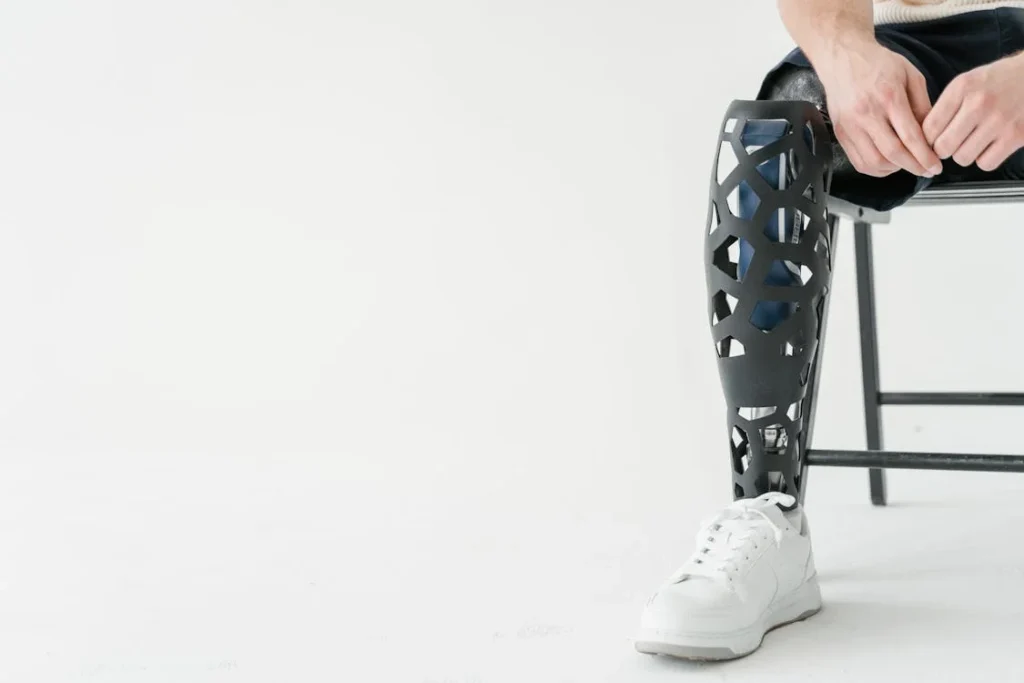Walking with a prosthetic leg is a journey of persistence, learning, and small victories. For most people using a prosthetic limb, walking is not just about putting one foot in front of the other. It’s about regaining freedom, rebuilding confidence, and feeling whole again. But this journey is often made harder by poor footwear and lack of proper orthotic support.
Footwear is not just fashion. For someone with a prosthetic limb, the right shoes can mean the difference between pain and comfort, a limp and a smooth stride, or even a fall and a steady walk. It’s surprising how something as simple as the shoe you wear can affect everything — from your hip and back to your overall balance and energy levels.
Orthotics — which includes inserts, insoles, braces, and other support tools — play an equally powerful role. They don’t just support your body. They help guide it, protect it, and shape the way you walk. When combined with the right shoes, orthotics can transform a tiring and clunky gait into one that feels almost natural.
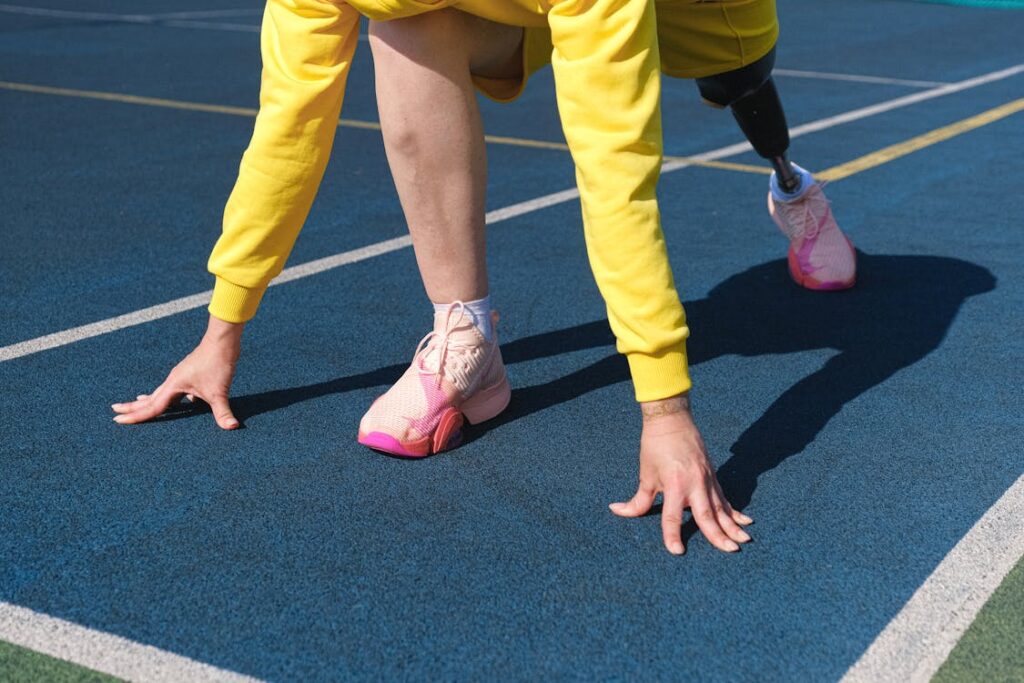
Understanding the Link Between Footwear, Orthotics, and Prosthetic Gait
Why Your Gait Matters More Than You Think
Your gait is the way you walk — how your foot strikes the ground, how your weight shifts, how your hips and spine respond, and how your prosthetic leg keeps up with all of it. For most able-bodied people, this happens naturally and without thought. But when you’re using a prosthetic leg, every movement becomes intentional. You learn to balance differently. You adjust your stride. You adapt, constantly.
What makes this adaptation successful is not just the prosthetic itself. It’s the whole system working together — your body, your mind, the artificial limb, and most importantly, the surface under your foot. The shoes you wear and the orthotic devices you use play a powerful role in shaping your entire walking pattern.
Many prosthetic users don’t realize this. They focus on getting the best prosthesis but then wear old or unsuitable shoes that throw off their balance or cause strain. Or they walk without orthotic aids that could reduce pain, improve control, and help them conserve energy.
When your gait is optimized, walking feels smoother. Your steps become more equal. Your hips don’t swing awkwardly. You feel more stable. Over time, this prevents long-term joint problems and lowers the chances of falls or injuries. More importantly, you feel more confident and less tired at the end of the day.
What Happens When the Support Is Not Right
When someone wears shoes that are too heavy or uneven, it can cause their prosthetic side to hit the ground too early or too late. This throws off the entire rhythm. Sometimes, it forces the user to swing their leg around instead of moving it straight ahead. Other times, it makes the user lift their hip unnaturally just to clear the ground. This leads to hip pain, back pain, and over time, poor alignment in the spine.
Similarly, without proper orthotic inserts or heel cushioning, the residual limb can take too much pressure inside the socket. That pressure can cause skin issues, sore spots, and even long-term socket discomfort. Some users compensate for this pain by limping, leaning, or taking shorter steps — all of which hurt their posture and mobility.
These small problems, if ignored, slowly become bigger ones. The knees might start to ache. The back begins to tighten. You might find yourself feeling off-balance on certain surfaces, or needing a walking aid more often than you used to.
And here’s something else that often gets overlooked — the sound of your steps. A noisy, uneven footfall isn’t just embarrassing in public. It’s often a sign that something is not aligned. A proper gait is quiet and efficient. When the footwear and orthotics are chosen correctly, they absorb shock better and guide each step more naturally.
The Invisible Energy Cost of a Poor Gait
People often assume walking with a prosthetic leg is mostly about muscle control. But in truth, energy plays a huge role. Every extra movement, every unnecessary shift, every imbalance — it all costs you energy. If your gait is not optimized, you might be burning double the energy compared to someone walking with a more natural stride.
This is where the right footwear and orthotics become your secret allies. They don’t just protect your feet. They return energy. They reduce effort. A good shoe helps with rollover during push-off. A cushioned heel softens the impact. An insert can guide your foot placement so you don’t waste effort on corrections.
Over the course of a day, these small savings add up. And for someone with a prosthetic limb, saving energy can mean walking longer, standing more comfortably, and avoiding exhaustion. It also leads to better focus. You don’t have to think so hard about every step. You can simply walk, and let your body do the rest.
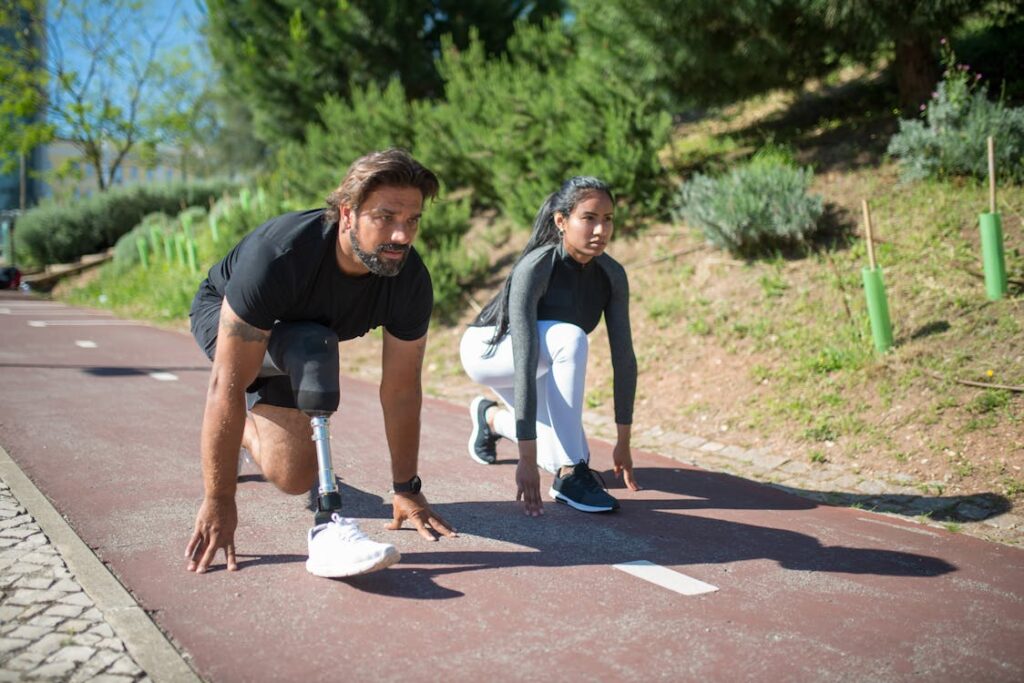
Choosing the Right Footwear for Prosthetic Gait Support
What Makes a Shoe “Right” for a Prosthetic User
When it comes to shoes and prosthetic walking, the word “right” doesn’t mean expensive or stylish. It means stable, supportive, and suited to your body’s unique needs. Every prosthetic user walks differently, depending on the type of amputation, the level of mobility, and the kind of prosthesis they use. So, the perfect shoe is one that works with your body — not against it.
One of the first things to understand is heel height. A shoe with the wrong heel height can completely throw off your prosthetic alignment. If the heel is too high, it pitches you forward unnaturally. If it’s too low, your gait becomes stiff and awkward. This mismatch doesn’t just affect the way you walk. It affects how your socket fits, how your weight is distributed, and how much control you have over your steps.
Shoe stiffness is another important factor. Too much flexibility in the sole can lead to instability, especially during toe-off, when your body is moving forward and the prosthetic foot is pushing off the ground. On the other hand, a shoe that is too rigid doesn’t allow your foot to roll properly. That stiffness gets transferred to your knee, hip, and lower back.
Then there’s the matter of cushioning. For prosthetic users, heel cushioning is more than just comfort — it’s a form of protection. Every step you take sends force through your body. A cushioned heel softens that impact, reduces stress on your joints, and helps your body stay in rhythm with your prosthetic side. This is especially helpful on hard surfaces like pavement, tiles, or concrete.
The overall weight of the shoe also matters. A heavy shoe may look sturdy, but it puts extra strain on the residual limb and the muscles that control your prosthetic leg. Lighter shoes help you move more freely, reduce fatigue, and make balance easier. But again, too light can be a problem if it lacks support or stability.
And finally, the inner structure of the shoe — the arch, the heel counter, and the depth — must match your foot and socket needs. If your shoe doesn’t hold your foot in place properly, it leads to side-to-side motion, rubbing, or even slipping inside the shoe. This friction can cause blisters or pressure sores, especially in diabetic or sensitive users.
How to Know if a Shoe is Working for You
Often, people judge shoes based on looks or brand reputation. But for prosthetic users, results speak louder. If a shoe is working well for you, your steps will feel smoother, not forced. You’ll notice less strain in your hip and back. You’ll find yourself walking longer without feeling tired. Your prosthesis will feel like part of your body — not an object you have to control all the time.
Try to observe how your body feels at the end of the day. Do you feel lopsided? Are you shifting your weight to your sound limb more than usual? Are you leaning forward or backward when standing still? These are all signs that your footwear may not be doing its job.
You can also check your wear pattern. Look at the bottom of your shoes. Uneven wear — more on one side, or heavier in one area — usually means your gait isn’t aligned properly. This is a clue that something needs adjusting, either in your prosthesis or your shoes.
Another good test is how stable you feel on uneven surfaces. If you often feel wobbly on gravel, grass, or slopes, your shoes may not be offering enough grip or support. Or, they may not be aligning your foot properly, causing you to overcompensate with your knees or hips.
The most important sign, however, is how confident you feel. Confidence comes from knowing your next step will land safely. The right shoes give you that quiet assurance. They don’t slip. They don’t twist your ankle. They don’t make you question every step.
Common Mistakes to Avoid with Shoes and Prosthetics
One common mistake is rotating between many different types of shoes without adjusting your prosthetic alignment each time. Each shoe has a different sole height and shape. So, even a one-inch difference in heel height can throw off your alignment. That misalignment might be small, but over time, it leads to pain and poor posture.
Another mistake is choosing shoes that are too soft. While soft feels good at first, it can also lead to foot instability. Your prosthetic foot needs a firm base to push off from. If the shoe compresses too much, it robs you of that power and makes your steps less efficient.
Wearing worn-out shoes is another big issue. As the soles wear down, the support and cushioning fade. What once felt like a great fit now adds more strain. Many prosthetic users forget to replace their shoes regularly because the damage is not always visible. But if the shoe feels uneven or loose, it’s time for a new pair.
Finally, avoid choosing footwear without consulting your prosthetist or gait specialist. What works for one user might not work for another. Your prosthesis is tuned for your body, and your shoes need to match that system. Making changes without professional input can undo your progress.
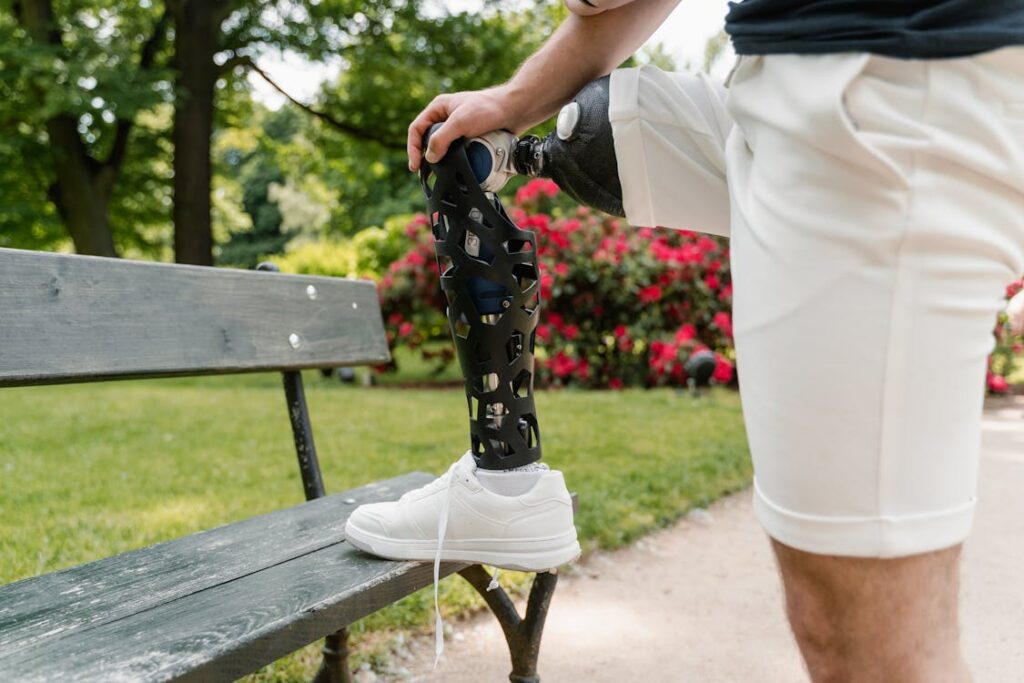
The Role of Orthotic Support in Enhancing Gait with a Prosthesis
What Orthotics Actually Do for Prosthetic Users
Orthotics are more than just shoe inserts. They are tools that guide and support how your body moves. For someone using a prosthetic limb, they fill in the missing support that your natural leg once provided. A prosthesis can mimic the shape and basic function of a limb, but it doesn’t have muscles, tendons, or nerves. That’s where orthotics step in — to help manage force, alignment, and control during walking.
Think of them as silent assistants. They adjust pressure where needed, offer stability during heel strike, and help manage motion during toe-off. They also reduce the risk of pressure sores, especially for users who have residual limb sensitivity or uneven leg lengths. In many cases, orthotics help reduce the stress placed on your sound limb, which often ends up working harder to compensate for the prosthetic side.
For instance, a properly designed footbed insert can ensure that weight is distributed more evenly across your foot. This prevents certain areas — like the heel or the ball of the foot — from getting overused. It also helps keep the knee and hip in better alignment with every step. Over time, this kind of subtle control prevents injuries and leads to better comfort, especially during long walks or active movements.
Types of Orthotics Commonly Used with Prosthetics
Orthotic support for prosthetic users comes in many forms, depending on the user’s specific needs. Some people need soft cushioning. Others need firm guidance. And some need custom-molded devices made to match their limb, gait, and daily activities.
Heel wedges, for example, are used to correct foot posture or help with balance issues caused by uneven weight distribution. Arch supports can help reduce midfoot collapse and maintain alignment during mid-stance. Toe fillers can be used for partial foot amputees to restore the foot shape and ensure shoe fit. For above-knee prosthetic users, orthotic components may even be placed inside the socket to improve hip control and limb comfort.
There are also hybrid solutions where orthotic designs are built into the prosthetic foot or socket itself. This often includes shock-absorbing pylons, torsion adaptors, or ankle components that add controlled motion or flexibility. While not traditional orthotics, these features play a similar role in optimizing the gait.
In India, ready-made orthotics are widely available, but they often lack the personalization that prosthetic users require. A prosthetic limb already changes the biomechanics of walking. So, the orthotics used must be designed with that in mind. Off-the-shelf insoles rarely meet these needs. Instead, semi-custom or fully custom orthotics — evaluated and adjusted by a prosthetist or physical therapist — deliver better results.
How Orthotics Can Improve Long-Term Joint Health
Many prosthetic users don’t think about their knee, hip, or back until pain shows up. But the truth is, your joints respond to every step you take. If your gait is not balanced, those joints start working in ways they weren’t designed to. That extra work leads to fatigue, inflammation, and eventually, injury.
Orthotics reduce this risk by keeping the body in better alignment. When your foot lands correctly, your knee tracks better. Your hip doesn’t twist or tilt unnecessarily. Your spine stays centered. These small improvements might not feel dramatic at first, but they add up. Over weeks and months, they reduce stress on your joints and keep your movements more efficient.
Another benefit is reduced limb difference compensation. Most prosthetic users have one limb doing more work than the other. This imbalance often leads to overuse injuries in the sound limb. Orthotics help share the load. By guiding both sides of the body more evenly, they reduce the workload on the natural limb and improve the overall symmetry of movement.
Proper orthotic use also means fewer socket problems. A common issue with prosthetic users is skin irritation or pressure buildup in the socket. Orthotics can adjust the way weight is transferred through the prosthesis, reducing these problems. When the body moves in a more natural pattern, the socket fits better, feels better, and stays more comfortable.
When and How to Adjust Orthotic Support
Orthotics are not “set it and forget it.” Your body changes. Your activity levels change. Sometimes, even your prosthesis changes. That means your orthotic needs will change too. What worked six months ago might not be right today.
Regular checkups are essential. If you notice new pain in your lower back, hip, or knee, it might be due to worn-out or poorly fitting orthotic support. If your walking pattern suddenly changes — maybe you start limping or favoring one side — it’s time to get your gait reassessed. Orthotic materials also wear down. Soft foam compresses. Hard shells can warp. Over time, they lose their effectiveness even if they look fine on the outside.
If you’re active — especially if you walk on uneven ground or engage in sports — you may need different orthotics for different activities. A high-impact sport may require shock absorption and more rigid control, while daily walking might need cushioning and flexibility. Having more than one setup might seem like a luxury, but in reality, it’s a smart investment in your mobility and joint health.
Just like with footwear, you should never make big changes to your orthotic support without guidance. Work with your prosthetist or physical therapist. They’ll observe how you walk, check how your limbs respond, and make data-driven decisions on what kind of support is best for you.

How to Work With Professionals to Find the Right Fit
The Importance of a Team Approach
Finding the best footwear and orthotic support isn’t something you should have to figure out alone. One of the most powerful steps you can take as a prosthetic user is to work with a team of professionals who understand how everything connects. This includes your prosthetist, physiotherapist, orthopedic doctor, and sometimes even a footwear specialist or pedorthist.
Your prosthetist is usually the first person to consult. They understand how your limb moves, how your prosthetic socket fits, and what kind of support you need. But their job becomes even more effective when they collaborate with others. For example, a physiotherapist can analyze your gait during motion, not just while standing still. They can help spot problems with balance, stride, or joint motion that might not show up during a static fitting.
An orthopedic doctor can offer medical insight into any underlying joint or muscular conditions that might be affecting your walk. And if you’re dealing with foot shape issues, pressure sensitivity, or specific shoe needs, a pedorthist can suggest modifications that a regular shoe store cannot provide.
These experts bring different pieces of the puzzle. When they work together, the outcome is far more precise, comfortable, and effective. You’ll walk better. You’ll feel more in control. And your risk of injury will drop significantly.
What a Proper Gait Assessment Looks Like
One of the most important services you should ask for is a gait assessment. This isn’t just someone watching you walk up and down a hallway. A proper gait assessment uses both observation and tools like pressure mats, motion capture, or video analysis. These methods help your team understand exactly how your feet land, how your weight shifts, and where imbalances may be happening.
The results of the gait assessment help shape everything that follows. Your team might adjust your prosthesis alignment, recommend a specific kind of shoe sole, or even build a custom orthotic that corrects a particular movement pattern.
Don’t be afraid to ask questions during this process. Understanding your gait helps you make smarter choices. You’ll start to notice small things — like how your steps feel on different surfaces, or how your back reacts after walking for long periods. This awareness helps you become an active participant in your mobility care.
Custom vs. Off-the-Shelf: Making the Right Decision
In India, and in many parts of the world, off-the-shelf solutions are more affordable and easily available. But they’re not always the best choice, especially for someone using a prosthetic limb. While a ready-made insole or shoe might work for a general user, it often lacks the structure or support needed for someone with altered biomechanics.
A custom solution, though more expensive upfront, is tailored to your exact needs. It considers your limb length, your prosthesis type, your activity level, and your unique walking pattern. The materials used are also more durable and suited to the wear and tear of daily prosthetic use. More importantly, custom devices are adjustable. As your needs change, the support can be modified to match.
That said, not everyone needs a fully custom setup. For users with stable gait patterns and minimal complaints, a semi-custom or well-chosen off-the-shelf product may be enough — especially if it’s fitted properly by a specialist. The key is not to guess. Use data, assessments, and professional input to make the right choice for your specific situation.
Regular Reviews and Follow-Ups Are Key
Even if everything is working well, you should revisit your gait and support system at least once a year. The human body changes — sometimes slowly, sometimes quickly. Weight gain or loss, changes in activity levels, or even minor injuries can throw off your balance and gait. What felt comfortable six months ago may start to feel awkward or painful.
Your prosthetic alignment may also shift slightly over time, and your socket might wear in ways that affect how your foot lands. Regular follow-ups ensure these issues are caught early. That means less discomfort, fewer complications, and more freedom in your daily movement.
It’s also a good time to update your footwear. Most active users should replace shoes every 6 to 12 months, even if they still look okay from the outside. The internal support materials degrade with use, and once that happens, your gait suffers.
The message here is simple: don’t wait for a problem to get bad. Stay proactive. Keep your team involved. Ask questions. The more engaged you are, the better your long-term results will be.
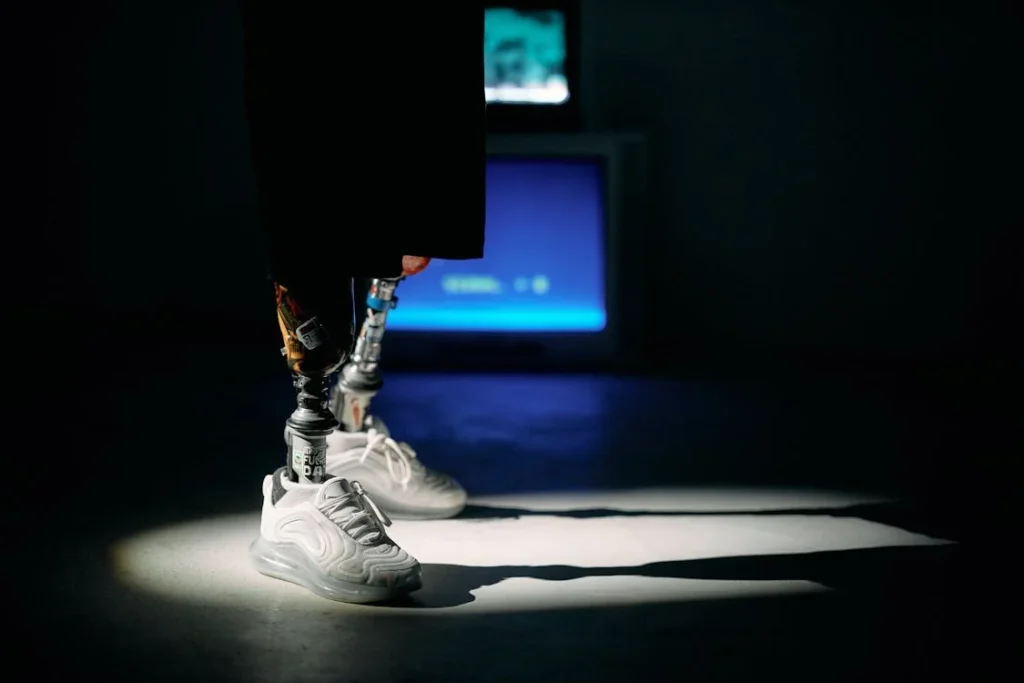
Real-World Tips to Improve Daily Walking Comfort and Stability
Starting With Your Routine and Environment
Improving your gait with prosthetic support isn’t only about equipment. Your day-to-day habits, your surroundings, and even how you carry yourself have a huge impact on your walking quality. The first step is to look at your routine. Are you walking mostly indoors or outdoors? Do you often walk on uneven ground, climb stairs, or stand for long hours? These details affect the type of footwear and orthotic design that works best for you.
For example, if you’re mostly walking on hard, polished floors at work or at home, you’ll need more shock absorption and grip. Slippery surfaces increase the risk of falls, especially if your shoe sole is too smooth. On the other hand, if you’re regularly walking on sand, grass, or broken pavements, then a firmer sole with better traction will give you more control and help you walk with less strain.
Think about how often you sit, stand, or switch between the two. Long periods of standing can put extra pressure on your joints, especially if your shoes don’t support your arches properly. Even small adjustments like rotating between two pairs of footwear or using a footrest while standing at a counter can reduce fatigue and protect your joints.
Also, pay attention to how you start and stop your walk. Many prosthetic users feel unsteady when they first stand up or when they change direction quickly. Practicing these transitions — and wearing supportive shoes with a firm heel counter — can greatly improve your confidence and reduce hesitation.
How to Train Your Body to Support a Better Gait
Even with the best footwear and orthotic support, your muscles need to do their part. Gait optimization is not only about what’s on your feet — it’s also about the strength and control of the rest of your body. The stronger and more balanced your muscles are, the smoother and more natural your steps will feel.
You don’t need a gym membership or fancy equipment. Simple exercises like hip bridges, leg raises, and controlled weight shifts can help. Focus on building strength in your core, hips, and the muscles around your knees. These areas carry most of the load when you walk with a prosthesis.
Balance exercises are just as important. Try standing on your sound leg with your eyes closed for a few seconds. Then practice small shifts of weight from one leg to the other while standing still. Over time, these exercises help your body respond faster to changes in terrain, making walking more stable and less tiring.
If you’re able to work with a physical therapist, ask them to guide you through movement drills that improve stride length, step timing, and limb control. These drills train your brain and body to work together, reinforcing good habits and reducing compensatory patterns like over-swinging the prosthetic leg or leaning too far to one side.
Listening to Pain and Discomfort — And Acting on It
One of the most important skills any prosthetic user can develop is listening to their body. Pain is not something to ignore or fight through. It’s a signal. It tells you that something isn’t working the way it should. Whether it’s a sharp pain in your hip or a dull ache in your lower back, your body is trying to tell you that your gait needs attention.
Many users brush off small discomforts, thinking they’re just part of the process. But these little aches often grow into chronic issues if the root cause isn’t addressed. If walking suddenly feels harder than usual, or if a familiar route leaves you unusually tired, don’t push through. Stop, take a closer look, and consider if it’s time to review your footwear or orthotics.
Sometimes the fix is as simple as tightening a shoe lace or adjusting an insert. Other times, it might involve changing your prosthetic alignment or updating your walking aids. Either way, action is better than delay. Regular discomfort is not something you should have to live with. With the right support, walking can and should be smooth, safe, and even enjoyable.
Managing Wear and Tear on Footwear and Orthotics
Just like tires on a car, your footwear and orthotic support wear down over time. But the wear is often so gradual that you don’t notice it right away. A shoe that used to feel stable starts to feel loose. An insert that once gave firm support now feels soft or flat. This wear and tear reduces the protection your body gets with every step.
Check your shoes from time to time. Look at the soles — especially the heel and the area under the toes. If they look uneven or overly compressed, it’s time for a replacement. Also check the inside. If the insole feels thinner or if the shoe has lost its shape, it won’t offer the same level of support it once did.
For orthotics, pay attention to how they feel inside your shoe. Are they still giving the same level of lift, cushioning, or guidance? If they feel “off” or if your gait has changed, have them checked. Most orthotic materials degrade after a year of regular use, even if they appear fine on the surface.
Keeping a simple calendar note to review your footwear and support system every six months can help you stay on top of these issues. It’s a small habit that makes a big difference.
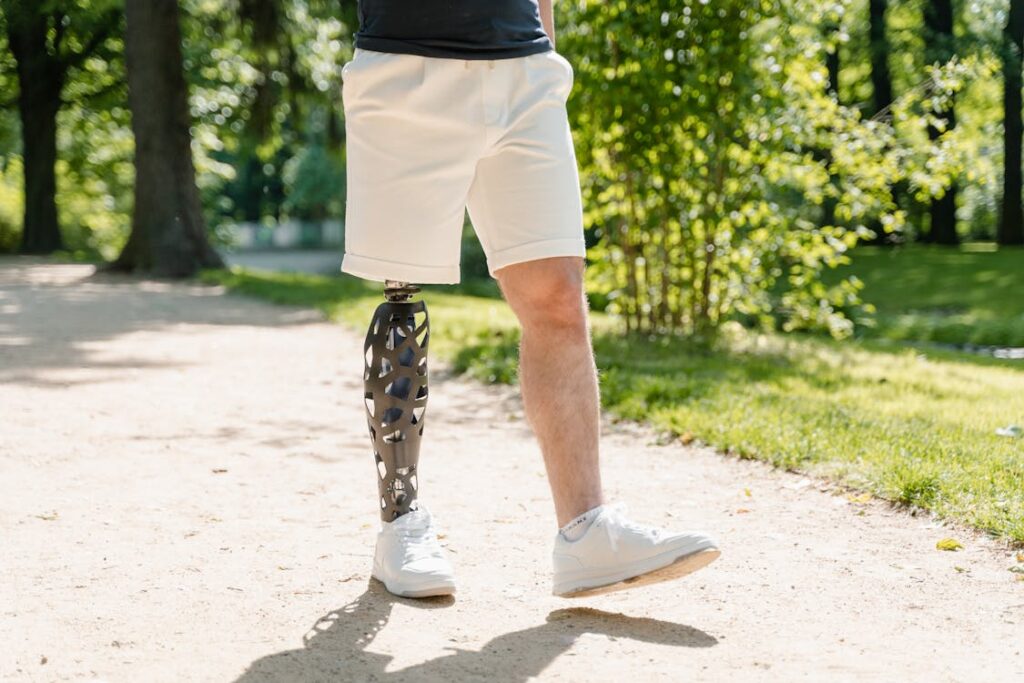
Looking Ahead: Building Confidence With Every Step
Your Gait Is Not Just Movement — It’s Freedom
Walking is one of the most basic human functions, yet for prosthetic users, it’s something that often has to be re-learned, refined, and constantly managed. And while the prosthesis is at the heart of it, the real secret to smoother, more natural walking lies in what supports it — your footwear and orthotics.
When your shoes support you well, you feel grounded. When your orthotics guide you properly, your steps feel balanced. And when both work together in sync with your prosthesis, your gait becomes fluid. Suddenly, walking is no longer a tiring task or a series of calculated movements — it becomes effortless again.
But the biggest shift is not just in how your body moves. It’s in how you feel. You stop focusing on every step and start focusing on where you’re going. That’s when true confidence returns. Whether you’re walking across your home, down the street, into your workplace, or around your neighborhood, every step becomes a statement of ability and independence.
Creating a Long-Term Plan for Gait Optimization
Gait optimization is not a one-time achievement. It’s a process — a series of small adjustments and choices that build up over time. The shoes you pick, the inserts you use, the exercises you do, and the way you listen to your body all play a part. There will be days when it feels perfect, and days when you’ll need a small tune-up. That’s perfectly normal.
What matters most is consistency and awareness. Make it a habit to review your walking comfort every few months. Keep an open line with your prosthetist or gait specialist. Update your footwear regularly and replace worn orthotics before they stop doing their job. The sooner you respond to small discomforts, the less chance they have to grow into bigger problems.
Above all, give yourself credit. Every step you take is backed by strength, adaptability, and effort. You’re not just walking — you’re overcoming.
Conclusion
Walking with a prosthetic limb is more than just movement — it’s about reclaiming freedom, balance, and comfort. The right footwear and orthotic support don’t just protect your body, they transform your gait. They ease your steps, reduce joint strain, and help you walk with confidence, not caution.
At Robobionics, we believe every prosthetic user deserves more than functionality — they deserve to feel natural in motion. Whether you’re taking short walks at home or navigating busy city streets, the support under your feet matters.
Gait optimization is not a luxury. It’s a necessity for long-term health, energy, and independence. Stay consistent, stay informed, and stay proactive. Choose shoes that work with your prosthesis, not against it. Use orthotics that support your unique stride. And always listen to your body.
You’re not just walking — you’re moving forward. And every step counts. If you ever need help fine-tuning that step, we’re here for you.



